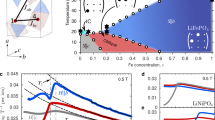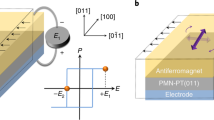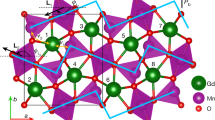Abstract
Controlling magnetism by means of electric fields is a key issue for the future development of low-power spintronics1. Progress has been made in the electrical control of magnetic anisotropy2, domain structure3,4, spin polarization5,6 or critical temperatures7,8. However, the ability to turn on and off robust ferromagnetism at room temperature and above has remained elusive. Here we use ferroelectricity in BaTiO3 crystals to tune the sharp metamagnetic transition temperature of epitaxially grown FeRh films and electrically drive a transition between antiferromagnetic and ferromagnetic order with only a few volts, just above room temperature. The detailed analysis of the data in the light of first-principles calculations indicate that the phenomenon is mediated by both strain and field effects from the BaTiO3. Our results correspond to a magnetoelectric coupling larger than previous reports by at least one order of magnitude and open new perspectives for the use of ferroelectrics in magnetic storage and spintronics.
This is a preview of subscription content, access via your institution
Access options
Subscribe to this journal
Receive 12 print issues and online access
$259.00 per year
only $21.58 per issue
Buy this article
- Purchase on Springer Link
- Instant access to full article PDF
Prices may be subject to local taxes which are calculated during checkout





Similar content being viewed by others
References
Chappert, C., Fert, A. & Nguyen Van Dau, F. The emergence of spin electronics in data storage. Nature Mater. 6, 813–823 (2007).
Weiler, M. et al. Voltage controlled inversion of magnetic anisotropy in a ferromagnetic thin film at room temperature. New J. Phys. 11, 013021 (2009).
Lahtinen, T. H. E., Franke, K. J. A. & van Dijken, S. Electric-field control of magnetic domain wall motion and local magnetization reversal. Sci. Rep. 2, 258 (2012).
Ghidini, M. et al. Non-volatile electrically-driven repeatable magnetization reversal with no applied magnetic field. Nature Commun. 4, 1421–1427 (2013).
Garcia, V. et al. Ferroelectric control of spin polarization. Science 327, 1106–1110 (2010).
Pantel, D., Goetze, S., Hesse, D. & Alexe, M. Reversible electrical switching of spin polarization in multiferroic tunnel junctions. Nature Mater. 11, 289–293 (2012).
Chiba, D. et al. Electrical control of the ferromagnetic phase transition in cobalt at room temperature. Nature Mater. 10, 853–856 (2011).
Molegraaf, H. J. A. et al. Magnetoelectric effects in complex oxides with competing ground states. Adv. Mater. 21, 3470–3474 (2009).
Zakharov, A. I., Kadomtseva, A. M., Levitin, R. Z. & Ponyatovskii, E. G. Magnetic and magnetoelastic properties of a metamagnetic iron–rhodium alloy. Sov. Phys. JETP 19, 1348–1353 (1964).
Stamm, C. et al. Antiferromagnetic-ferromagnetic phase transition in FeRh probed by x-ray magnetic circular dichroism. Phys. Rev. B 77, 184401 (2008).
Heeger, A. J. Pressure dependence of the FeRh first-order phase transition. J. Appl. Phys. 41, 4751–4752 (1970).
De Vries, M. A. et al. Hall-effect characterization of the metamagnetic transition in FeRh. New J. Phys. 15, 013008 (2013).
Gray, A. et al. Electronic structure changes across the metamagnetic transition in FeRh via hard X-ray photoemission. Phys. Rev. Lett. 108, 257208 (2012).
Vaz, C. A. F. Electric field control of magnetism in multiferroic heterostructures. J. Phys. Condens. Matter 24, 333201 (2012).
Naito, T., Suzuki, I., Itoh, M. & Taniyama, T. Effect of spin polarized current on magnetic phase transition of ordered FeRh wires. J. Appl. Phys. 109, 07C911 (2011).
Cher, K. M., Zhou, T. J. & Chen, J. S. Compositional effects on the structure and phase transition of epitaxial FeRh thin films. IEEE Trans. Magn. 47, 4033–4036 (2011).
Kay, H. F. & Vousden, P. Symmetry changes in barium titanate at low temperatures and their relation to its ferroelectric properties. Phil. Mag. 40, 1019–1040 (1949).
Fan, R. et al. Ferromagnetism at the interfaces of antiferromagnetic FeRh epilayers. Phys. Rev. B 82, 184418 (2010).
Maat, S., Thiele, J-U. & Fullerton, E. Temperature and field hysteresis of the antiferromagnetic-to-ferromagnetic phase transition in epitaxial FeRh films. Phys. Rev. B 72, 214432 (2005).
Rado, G., Ferrari, J. & Maisch, W. Magnetoelectric susceptibility and magnetic symmetry of magnetoelectrically annealed TbPO4 . Phys. Rev. B 29, 4041–4048 (1984).
Eerenstein, W., Wiora, M., Prieto, J. L., Scott, J. F. & Mathur, N. D. Giant sharp and persistent converse magnetoelectric effects in multiferroic epitaxial heterostructures. Nature Mater. 6, 348–351 (2007).
Zhang, S. et al. Electric-field control of nonvolatile magnetization in Co40Fe40B20/Pb(Mg1/3Nb2/3)0.7Ti0.3O3 structure at room temperature. Phys. Rev. Lett. 108, 137203 (2012).
Hu, J-M., Nan, C-W. & Chen, L-Q. Size-dependent electric voltage controlled magnetic anisotropy in multiferroic heterostructures: Interface-charge and strain comediated magnetoelectric coupling. Phys. Rev. B 83, 134408 (2011).
Baldasseroni, C. et al. Temperature-driven nucleation of ferromagnetic domains in FeRh thin films. Appl. Phys. Lett. 100, 262401 (2012).
Ovchinnikov, I. & Wang, K. Theory of electric-field-controlled surface ferromagnetic transition in metals. Phys. Rev. B 79, 020402(R) (2009).
Abo, G. S. et al. Definition of magnetic exchange length. IEEE Trans. Magn. 49, 4937–4939 (2013).
Sandratskii, L. M. & Mavropoulos, P. Magnetic excitations and femtomagnetism of FeRh: A first-principles study. Phys. Rev. B 83, 174408 (2011).
Meyerheim, H. et al. Structural secrets of multiferroic interfaces. Phys. Rev. Lett. 106, 2–5 (2011).
Park, S-E. & Shrout, T. R. Ultrahigh strain and piezoelectric behavior in relaxor based ferroelectric single crystals. J. Appl. Phys. 82, 1804–1811 (1997).
Wayne, R. Pressure dependence of the magnetic transitions in Fe–Rh alloys. Phys. Rev. 170, 523–527 (1968).
Challener, W. A. et al. Heat-assisted magnetic recording by a near-field transducer with efficient optical energy transfer. Nature Photon. 3, 220–224 (2009).
Thiele, J-U., Maat, S. & Fullerton, E. E. FeRh/FePt exchange spring films for thermally assisted magnetic recording media. Appl. Phys. Lett. 82, 2859–2861 (2003).
Hirori, H., Doi, A., Blanchard, F. & Tanaka, K. Single-cycle terahertz pulses with amplitudes exceeding 1 MV/cm generated by optical rectification in LiNbO3 . Appl. Phys. Lett. 98, 091106 (2011).
Rayson, M. J. & Briddon, P. R. Rapid iterative method for electronic-structure eigenproblems using localised basis functions. Comput. Phys. Commun. 178, 128–134 (2008).
Acknowledgements
We are very grateful to A. Gloter and S. Van Dijken for fruitful discussions and R. Mattana, C. Carrétéro, E. Lesne and R. Weil for technical assistance with SQUID measurements, sample growth and high-temperature MOKE. This work received financial support from the French Agence Nationale de la Recherche through project NOMILOPS (ANR-11-BS10-0016) and the European Research Council Advanced Grant FEMMES (contract no. 267579). R.O.C. acknowledges financial support by Thales through a CIFRE PhD grant.
Author information
Authors and Affiliations
Contributions
M.B. and A.B. initiated the study. A.B. and R.O.C. conceived the experiments. R.O.C. prepared the samples and performed RHEED with the assistance of E.J. L.C.P., I.C.I., B.D., N.G., R.O.C. and M.B. carried out the X-ray diffraction experiments. V.G., S.F. and R.O.C. measured the ferroelectric response of the samples. R.O.C. characterized the samples by SQUID magnetometry, A.M. by MOKE and L.C.P., A.A.Ü., S.V. and F.K. by X-PEEM. V.I. and A.Z. performed the first-principles calculations using the code developed by P.R.B. M.B. wrote the manuscript with inputs from V.I. and A.Z. All authors contributed to the manuscript and the interpretation of the data.
Corresponding authors
Ethics declarations
Competing interests
The authors declare no competing financial interests.
Rights and permissions
About this article
Cite this article
Cherifi, R., Ivanovskaya, V., Phillips, L. et al. Electric-field control of magnetic order above room temperature. Nature Mater 13, 345–351 (2014). https://doi.org/10.1038/nmat3870
Received:
Accepted:
Published:
Issue Date:
DOI: https://doi.org/10.1038/nmat3870
This article is cited by
-
Low-temperature grapho-epitaxial La-substituted BiFeO3 on metallic perovskite
Nature Communications (2024)
-
Static and dynamic magnetization control of extrinsic multiferroics by the converse magneto-photostrictive effect
Communications Physics (2023)
-
Non-volatile electric-field control of inversion symmetry
Nature Materials (2023)
-
Repeatable and deterministic all electrical switching in a mixed phase artificial multiferroic
Scientific Reports (2022)
-
Current-induced Néel order switching facilitated by magnetic phase transition
Nature Communications (2022)



